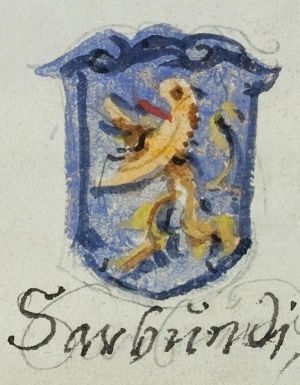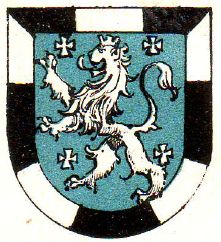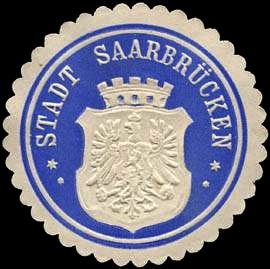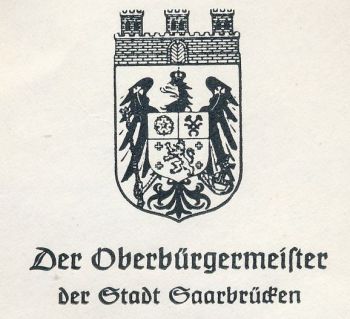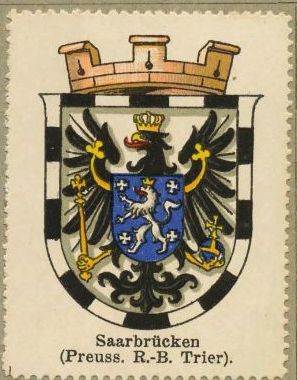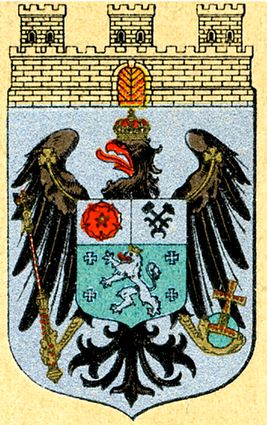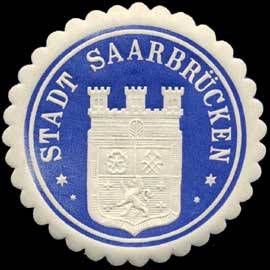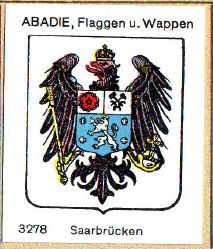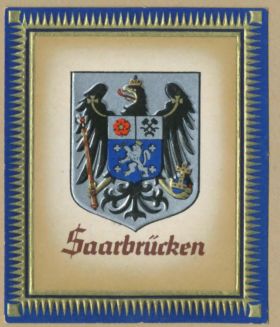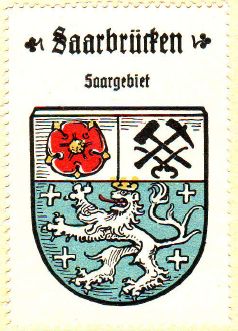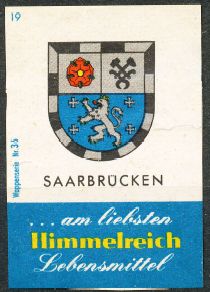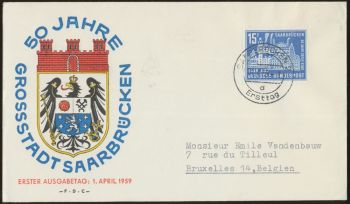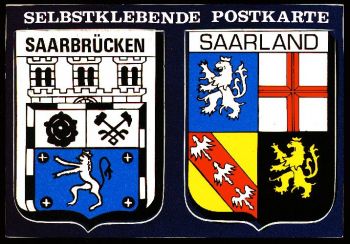Saarbrücken: Difference between revisions
Knorrepoes (talk | contribs) m (Text replacement - "{{media}}" to " {{de1}} {{media1}}") |
Knorrepoes (talk | contribs) m (Text replacement - "{{de}}" to "") |
||
| Line 1: | Line 1: | ||
'''SAARBRÜCKEN''' | '''SAARBRÜCKEN''' | ||
Revision as of 05:15, 27 December 2022
SAARBRÜCKEN
State : Saarland
District (Kreis) : Regionalverband Saarbrücken
Additions : 1909 Sankt Johann, Malstatt-Burbach; 1974 Altenkessel, Amt Brebach, Bischmisheim, Brebach-Fechingen (1959 Brebach, Fechingen), Bübingen, Dudweiler, Ensheim, Eschringen, Gersweiler, Güdingen, Klarenthal, Schafbrücke, Scheidt,
| German | Innerhalb eines von Schwarz und Silber gestückten Schildbordes unter gespaltenem silbernen Schildhaupt - darin rechts eine rote Rose mit goldenem Samen und grünen Kelchblättern, links schräggekreuzt ein schwarzer Schlägel und ein schwarzer Hammer, unter den Stielenden eine gestürzte schwarze Zange - in Blau ein goldgekrönter, goldbewehrter und rotgezungter silberner Löwe, bewinkelt von vier silbernen Tatzenkreuzen. |
| English | No blazon/translation known. Please click here to send your (heraldic !) blazon or translation |
Origin/meaning
The current arms were granted on September 21, 1976.
The oldest known seal of the cities of Saarbrücken and Sankt Johann was granted by Count Johan III of Nassau-Saarbrücken on March 6, 1462. This seal showed a shield with in the upper half the arms of the Counts of Saarbrücken-Commercy (a silver lion with four silver crosses) and ion the lower half a rose for Sankt Johann.
The seal was in use until the end of the 18th century (1793), restored in 1817 and used until 1856.
In 1856 the two cities separated and Saarbrücken used a shield with only the lion in a field with small crosses, the the arms of the Counts of Saarbrücken-Commercy.
On November 20, 1876, the city received two new arms from Emperor Wilhelm I. The arms were the arms as used from 1859, but now with a bordure in the colours of Prussia (black and silver) as small arms, and as large arms the same arms (without the bordure) placed in a shield with the Prussian eagle. These arms were used until 1909. The number of crosses was now reduced to four, as in the old seal.
| The arms in a 16th century manuscript | |
| The small arms as shown around 1900 |
|
| The large arms on a seal from around 1900 |
Municipal stationery, 1960s |
An interesting combination of the large arms with another Prussian bordure was shown in an album from +/- 1910, even though the arms had been changed in 1909.
| The large arms in the Wappen-Sammlung (+/- 1910) |
On April 1, 1909 new arms were granted after the merger of the three cities (Saarbrücken, Sankt Johann and Malstatt-Burbach) to new Saarbrücken. These arms show in the upper half the rose of Sankt Johann and the miner's tools from Malstatt-Burbach. The lion of Saarbrücken-Comemrcy is shown in the base. The whole surrounded by the Prussian bordure. Similarly as to the previous arms, the whole could also be placed on a shield with the Prussian eagle as large arms (but without the bordure). Both shields could be displayed with a mural crown.
| The large arms as granted in 1909 |
Seal with the small arms from around 1920 |
| The large arms in the Abadie albums (1930s) |
The large arms in a 1936 album |
After the First World War the arms were often shown without the Prussian bordure and/or eagle, see below, but the arms were officially valid until 1976.
| The arms by Hupp in the Kaffee Hag albums +/- 1925 |
The arms on a 1960s matchox label |
| The large arms on a 1959 cover |
The arms on a 1970s (?) postcard |
After the municipal reforms in 1974 the city needed either to design new arms, or have the old arms officially regranted. The council chose for the latter and applied again for the small and large arms, including the mural crown. After some discussion, only the small arms were officially granted, without the mural crown. These arms have been in use since.
Literature: Stadler, 1964-1971, 8 volumes; Hupp, O: Kaffee Hag albums, 1920s


